
Fleas are highly specialised bloodsucking parasites belonging to the order of insects called Siphonaptera, which means “wingless siphon.” They have a formidable reputation of claiming more victims than all the wars ever fought, as a result of the “bubonic” (Black Death) plague they spread throughout the world in the 14th century causing the deaths of over 200 million people. Now, these insects are better known for their irritation and pest status worldwide.
Fleas are light brown to mahogany in colour and roughly oval shaped. Their laterally fattened appearance enables them to quickly move through the host’s hair. Measuring 2-8 mm in length, the adults are entirely covered with a series of bristles and combs that assists them in clinging to the host. Both female and males fleas rely on blood for their nutrition, but can survive for several months without it. When a flea blood feeds, it will crouch low to penetrate the host’s tissue with a sawing motion of the mouthparts. A small amount of anti-coagulant is injected with the saliva, to permit easy siphoning of the blood.

A typical European wasp worker is about 1.75mm long, and is short and blocky. All European wasps are yellow and black or white and black. Paper wasps are 2mm long, and more slender. Paper wasps may be distinguished from European wasps by their long legs and by their colour. They usually red and yellow, or mostly yellow with small areas of black. Identification is important, as the two wasps have different nesting habits.

Bees are flying insects closely related to wasps and ants, and are known for their role in pollination and producing honey and beeswax. All bees have a head, throax and a abdomen. The many tasks of associated with maintaining the hive are divided among the worker bees in an age-based fashion (polytheism). That is individual bees perform the tasks in a specific sequence. The youngest bees clean the cells for about 3 days, then they are nurses to the brood for several days. From days 10 to 20, the bees engage in building activities and pollen storage and reception. At around 20 the bees stand guard at the hive entrance and after a few days the bees become foragers. Bees have a long proboscis ( a complex “tongue”) that enables them to obtain the nectar from flowers. They have antennae almost universally made up of 13 segments in males and 12 in females, as is typical for the superfamily. Bees all have two pairs of wings, the hind pair being the smaller of the two, in a very few species, one sex or caste has relatively short wings that make flight difficult or impossible, but none are wingless.
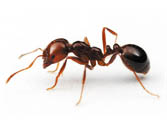
Ants are social insects of the family Formicidae and, along with the related wasps and bees, belong to the order Hymenoptera. They are easily identified by their elbowed antennae and a distinctive node-like structure that forms a slender waist. Ants form colonies that range in size from a few dozen predatory individuals living in small natural cavities to highly organised colonies that may occupy large territories and consist mostly of sterile wingless females forming castes of “ workers”. “soldiers”, or other specialised groups.
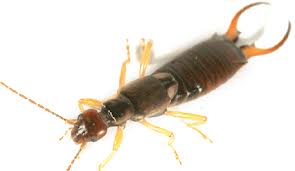
Earwigs are rather cryptic, small to medium sized insects distinguished from other insects by a pair of forcep or pincer-like cercl at the end of the abdomen. The name Dermaptera refers to the thickened leathery forewings and is derived from Greek with “derma” meaning skin and ” ptera’ meaning wings. There are different ideas as to where the English name ” earwig ” comes from, including the mistaken belief that earwigs have a tendency to crawl into a sleeping person’s ear, or because the hind wings resemble in shape the human ear. Another alternative is that ” earwig” is derived from the Angio Saxon English ” eard” meaning soil and ” wicga” meaning insect.
Identification: Earwig have an elongated and flattened or cylindrical body. They can be winged or wingless, and they have chewing mouthparts. The abdomen is long, flexible and telescopic ( segments of the abdomen are heavily sclerotized ( hardened) and vary in shape and size between species. The forewings, called "tegminal" are short and lack veins. The large, membranous and semicircular hindwings fold up fan-like under the tegminal and can be unfurled or folded very quickly. They come in a range in colours, including: yellow, yellow brown, orange brown, reddish brown, dark brown and black, and sometimes are a combination of these females can be readily distinguished from males as they are usually smaller, have simple forceps and eight visible abdominal ( hind-body ) segments as opposed to males, which have ten.
Size: Range 5mm – 50mm
Distribution: Earwigs are widely distributed throughout Australia with the highest diversity in the tropics and subtropics. The Australian fauna includes native and introduced species. There are 85 species of Australian earwigs described at present, however it is estimated that there is up to this number again of Australian earwig species yet to be described.
Habitat Earwigs: May be found in protected, moist environments in leaf litter and all kinds of debris on the ground, under bark, under stones, between leaves and some even inhabit crevices at the base of tightly packed and overlapping leaves of Pandanus. Earwigs are usually nocturnal and attracted to lights at night.
Feeding and Diet: Earwigs are mostly omnivorous eating a wide variety of live and decaying plant and animal material. Predominantly plant eating or predatory species are also known.
Life cycle: The earwig lifecycle is an incomplete metamorphosis. This means that when the nymphs ( or larvae) hatch from eggs they resemble the adult form. However, the nymphs can be distinguished from adults by having only wing buds, simple almost straight undeveloped forceps, and by their ecdysial line. This is a line down the centre of the head and thorax along which the cuticle splits when the nymphs moult. It is not seen on the final adult form. Nymphs moult four to five times before becoming an adult. Female earwigs care for their eggs and young nymphs, which is an unusual trait in most non-social insects. Females dig a short burrow on the ground beneath leaf litter and debris where they lay their eggs and which they defend from intruders. The females care for the eggs by collecting them up if they become scattered and clean the eggs by licking off fungus and parasites. After the young nymphs hatch the female feeds them up to the second or third moult, when they can the look after themselves, and at this stage the females may even become cannibalistic.
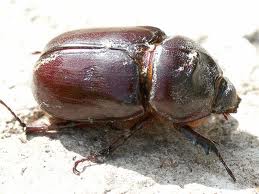
Beetles: Beetles make up 40% of all insects and there are eight times as many beetle species as there are fish, amphibian, reptile, bird and mammal species put together. Beetles are extremely diverse and are one of the most successful groups of animals in the world. The huge number of beetle species demonstrates their ability to live in almost any environment. Their front wings ( called elytra) are hard sheaths that protect the beetles’ hind wings and cover the breathing pores. This enables beetles to control their body temperature and retain water. Beetles also have diverse mouthparts, and eat anything from hardwood to the ooze from rotting fungi.
Beetle facts: Over one-quarter of all known species of animals are beetles. There are over 350.000 different known beetle species worldwide and new species are being discovered all the time. Some 1.500 species may occur in the Sydney region. Of the 30.000 species that may occur in Australia, only 20.000 are scientifically described. Beetles eat other insects, fruit, fungi, dead animal and plant material, and wood. Many species live in the nests of other animals.
Beetle Habitat: Beetles can be found in almost all available habitats, including in water. Terrestrial beetles are found: in soil and under rocks On or in flowers, leaves, fruits and seeds in leaf litter Under tree bark in rotting wood On animal carcasses in foodstuffs such as grains in nests of other animals.
Beetle Life Cycle: Beetles are holometabolous. This means that their larvae pupate before emerging as adult insects. Beetle larvae are often referred to as grubs. Beetle grubs are diverse in their shapes and habitats. Most beetle grubs live in concealed habitats, such as underground or inside trees. There are many aquatic species, and few which resemble caterpillars and feed openly on leaves. Many retain segmented legs, although weevil grubs nearly lack legs. Most legless beetle grubs have robust chewing mouthparts and can be distinguished from similarly-shaped fly maggots, which often have modified mouth "hooks".
Feeding: Beetles, both adults and grubs, use their chewing mouthparts to eat other insects, fruit, nectar, leaves, fungi, dead animal and plant material, and / or wood. Some beetles form symbiotic relationships with other insects such as termites, ants or bees, living in their nests and either being tolerated or even actively protected and/or fed by their hosts.
Predation and defence: Many beetles produce chemical compounds that protect them against attack from bacteria, fungi and/or predators. Special glands produce these chemicals, which either render the whole beetle unpalatable to predators or are specifically released upon attack. Beetles with these defences are often brightly coloured as a warning to potential predators.
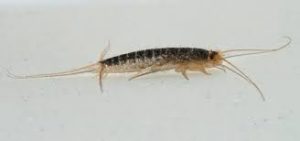
Silverfish: Silverfish belong to the Order Zygentoma ( formerly Thysanura).
Size: 2mm – 18mm in length.
Body: Column-like, tear-drop or spindle-shaped. Often hairy, with tufts common between eyes Appears hard and covered in scales. Have tiny styli ( soft finger-like projections) coming from the underside some of the abdomen segments.
Antennae: Thread-like, with many segments. Longer than half the body length.
Eyes: Absent or small, berry-like and well separated.
Mouthparts: For chewing. Held in front or downwards at rest.
Wings: Absent. Limbs: Six legs, short and stocky. Abdomen tip: Three tails ( two cerci and one middle filament), thread-like, and similar in size: at rest the two outer tails aredirected at an angle away from the body.
Where are silverfish found: Under bark, rocks or among leaf litter. In soil or within caves. In the deserts, as some are capable of absorbing water from the atmosphere. Living in ant and termite nests. In houses, where they favour areas of high humidity like bathrooms.
What do silverfish do: They often group together around food sources. When disturbed they remain still, run for cover or hop. They feed on fungi, and plant material. In the home they may feed on starchy substances such as wallpaper glue, book bindings and photographs. They are normally active at night, if active during the day generally found in dark places.
What looks similar: Bristletails are easily confused with silverfish. They maybe separated from silverfish by their large eyes that touch: their long middle tail, which is considerably longer than the cerci: and they jump when disturbed.
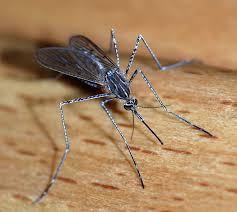
Mosquitoes: Mosquitoes it is only female mosquitoes that seek animals out for their blood, which they need in order to reproduce.
Standard Common Name: Mosquitoes
Number of Species: 350 Size ranged 4mm – 6mm.
Distribution: Mosquitoes are found throughout Australia.
Habitat: Mosquitoes often live in urban areas.
Feeding and Diet: The female mosquitoes eat animal blood.
Life cycle: A few days after a blood meal, female mosquitoes lay about 200 eggs on any water surface-even small water bodies such as bottom trays of pot plants are suitable. Most species produce egg ” rafts” where many eggs are cemented together, floating until they hatch after two to three days. Although they live in water, the larvae known as ” wrigglers” breathe air and come equipped with their own snorkelling equipment. Attached to their abdomen is a siphon, which they use when they come to the surface to breathe. Females live for about a month while males often live for only a week, during which they feed on nectar.
